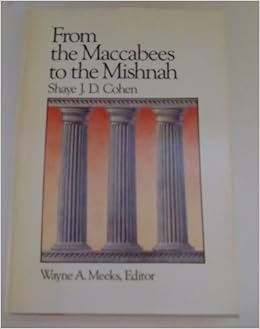This introduction to the transition that occurred in the Jewish faith during the early centuries of the Christian era does a good job of keeping things simple for those not intimately acquainted with the Jewish talmudic writings. The book wasn't quite what I was expecting, given that the title leads one to believe the account will be a narrative one, marching from a few centuries from Jesus to the rabbinic era that would follow a few centuries after. Cohen, however, opts to organize the book around themes more than chronology. While the lack of chronology was a bit disappointing to me, the themes prove to be an effective means to explore the transition nonetheless.
Cohen does, of course, provide some chronology, especially toward the beginning and end of his book, but that is mostly to give readers a bit of a skeleton onto which to hang the subjects that he addresses.
Among those subjects are the hellenization of the Jewish faith and the manner in which the Jewis faith existed in these early centuries. Cohen posits that religion was more of a practice, a way of life, than a philosophy for most Jewish people--and indeed for most religions until the tenets of Greek philosophy began to play a greater role in the thinking of peoples. As that took hold, some Jewish diasporic writers also tried to do more "thinking" on various theological subjects and even to pose Judaism as a philosophical religion that predated much of the philosophy that was emerging.
Cohen also explores the various sects that existed within the Jewish faith and how sectarianism in large part ceased as rabbinic structures took hold. The reason for this was in part because many sects were forged around criticism of temple authorities; once the temple no longer existed, the reason for the existence of many such sects also ceased to exist.
One chapter explores the canonization of the Jewish scriptures and the formation of the Mishnah, a subject dealt with by another book (Early Biblical Interpretation) in this series (The Library of Early Christianity) but that is summed up quite effectively in one chapter.
The final chapter focuses on the emergence of the rabbinic system.
As with all the books in this series, the fact that these books are in many ways summaries of prevailing research in the field makes them difficult to summarize themselves. But among the books in the series, this is one of the better ones.
Subscribe to:
Post Comments (Atom)







No comments:
Post a Comment